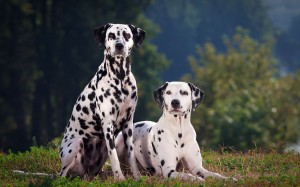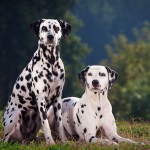Dalmatian
"Dalmatian dogs were incredibly popular after 1996 "101 Dalmatians" movie and its sequel, which led to many of them being abandoned by inexperienced owners in the following years."
Other names for this breed:Carriage Dog, Spotted Coach Dog, Firehouse Dog, Plum Pudding Dog
Breed nicknames:Dal
Country of origin:Croatia
Traits:
Height:Male 23–24 inches (58–61 cm), female 22–23 inches (56–58 cm)
Coat:White background
Color:White with black or liver spots
Litter size:9-13 puppies
Life span:10-13 years
Classification:
AKC - American Kennel Club: Non-sporting
UKC - United Kennel Club: Companion
TKC - The Kennel Club: Utility
NZKC - New Zealand Kennel Club: Non-Sporting
FCI - International: 6 - Scenthounds, 6.3 - Related Breeds
When you think of a black and white dog, or even a firehouse dog, what do you think of? Most likely, a Dalmatian comes to mind. These great companion dogs have been around for hundreds of years. And the breed has much more to offer than just their black and white (or even brown and white) distinctive coats. They are playful, energetic, and make a great family pet. Want to learn more about Dalmatians? Then read on.
History
Dalmatians originate from the country of Croatia. Specifically, the region known as Dalmatia. Since the 1600s, they have appeared in artwork, as well as literature of the region. It was thought they were originally bred to go to war and protect the borders of the Dalmatia area. Other used early Dalmatians were as hunters of rodents. They also make very good hunting dogs. Others were used as carriage dogs, meant to clear the path for horses drawing carriages. Still others associate them with the firehouse. As watchdogs, Dalmatians excel. Although you might not expect it, these dogs were very popular in England in the 1800s.
What This Breed Looks Like
We all know that Dalmatians have a spotted coat. Most are white with either black or brown spots. There are other color variations out there, however. Some, for instance, have patches instead of spots, even from the time that they are born. Spots tend to be grouped more heavily on the ears and skull, and develop as the dogs’ age. As puppies, Dalmatians are entirely white! Their coat is short, stiff, and fine. Dalmatian owners find that their dogs shed constantly. Males are larger than females are, and most Dalmatian dogs are around two feet tall at the shoulders.
What’s This Dog Like?
The Dalmatian is a highly energetic dog. They are also very intelligent. Submission is also very easy for this dog. Dalmatians are real people pleasers, and training them just takes positive reinforcement and plenty of leadership. If you bring a Dalmatian into your home, expect them to also be alert and interested in what you and others are doing. Lots of people get rid of the Dalmatian puppies within the span of a year. However, after a few years of consistent and good training, they will calm and become much more enjoyable as companion animals.
Care
Dalmatians should be exercised on a daily basis. You may want to take them on either jogs or long, brisk walks. You do not want your Dalmatian puppy living outdoors. However, just know that they will be very energetic indoors. They do best with a large yard to run and play. Be sure that this area is fenced in, however, or Dalmatians might try to run away and run for days. Keep fresh water out all the time for your Dalmatian, and be sure to keep track of when your dog urinates. Brush them with a dog mitt on a regular basis.
Ring Standard
For showing, Dalmatians that have only spots and no patches are preferred. Black and white or black and brown are usually shown exclusively in the ring. Spots should be very well defined and spread apart. The body should appear to be athletic and squarely proportioned. Gait should seem effortless. Eyes should be brown, blue, or both. The tail is never docked, but is tapered and meets the topline of the dog. Ears are set high upon the head, but droop downward. The skull is flat on top, and has a square appearance. The nose might vary in color.
Potential Health Issues
Dalmatians have lots of potential health issues, even though healthy animals live from a decade to around twelve years. The most common issue in Dalmatians is deafness. About 1 in 10 puppies are born deaf. Deaf dogs can be raised by skilled owners, though. Urinary stones is the second most common issue, which is why water must be available to your Dalmatian at all times, and you must monitor how often they urinate. Discuss this issue with your vet if you own a Dalmatian. Skin allergies might also be a problem in this dog. Keep them away from synthetic fibers, if possible.
Getting Your Own Dalmatian Puppy
Are you looking to adopt your own Dalmatian puppy? If so, then seek out reputable rescues. Clubs that are centered on the Dalmatian breed might also have information about local rescues to contact. Dalmatian Club of America, Inc. is a great national club. Local clubs may be able to provide you with the names of local, reputable kennels if you are looking to purchase a very young puppy. If you are seeking a deaf Dalmatian puppy to raise, do not do so in a home where children may be present. Local shelters may also have Dalmatian pups for adoption.
Dalmatian Photo Gallery
You can click on the gallery images below to view them full sized (most are in wallpaper resolution!).























































